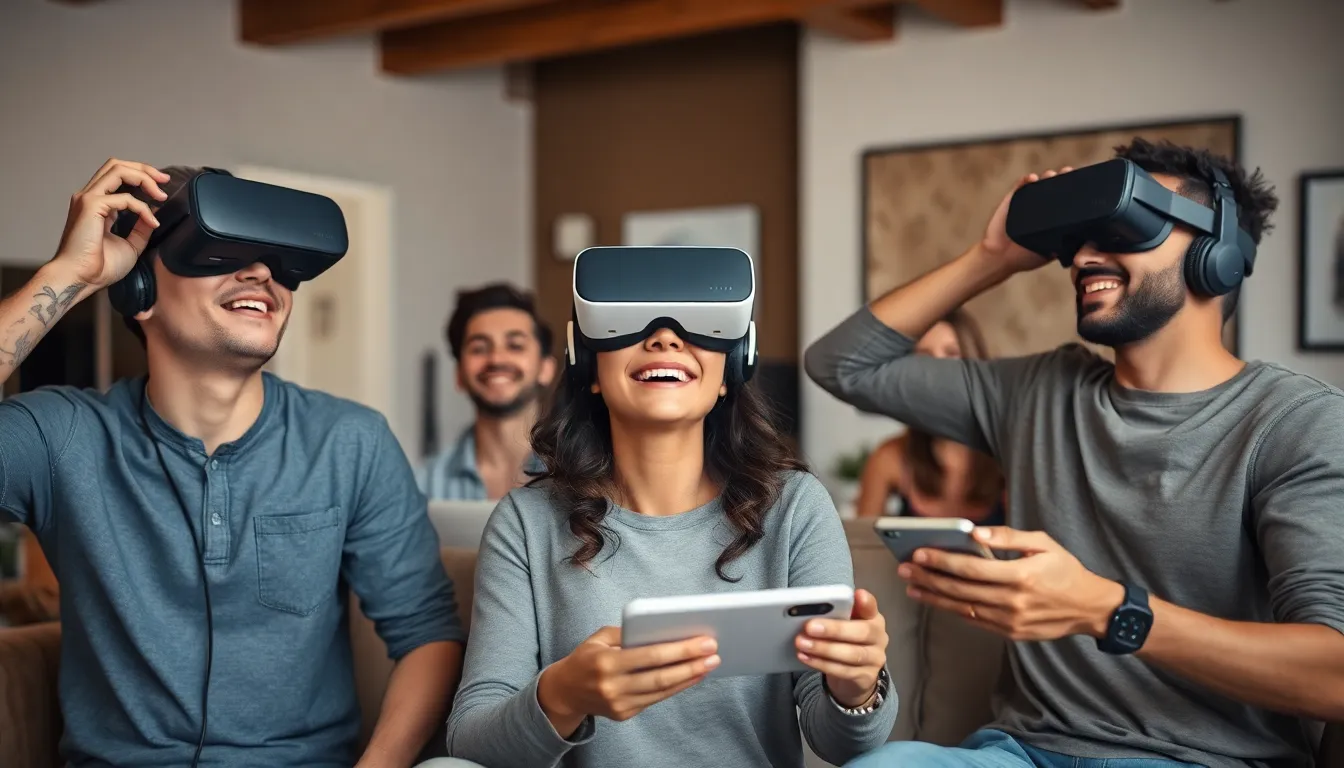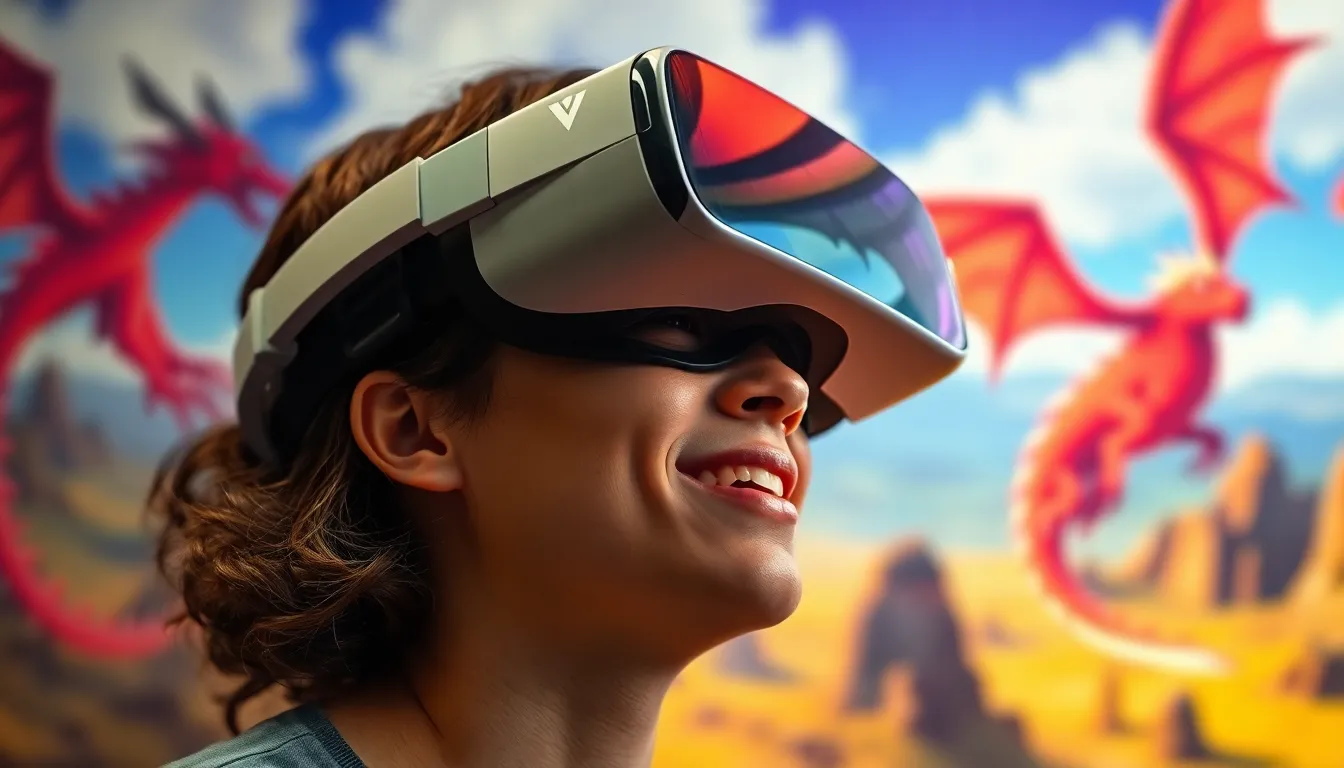Imagine slipping on a pair of futuristic goggles and suddenly finding yourself in a world where you’re battling dragons or sipping cocktails on a virtual beach. That’s the magic of VR headsets. They’ve transformed the way people experience gaming, entertainment, and even education, making reality feel like yesterday’s news.
Table of Contents
ToggleOverview of VR Headsets
VR headsets provide immersive experiences by leveraging advanced technology. Users enjoy engaging environments that feel real, from intense dragon fights to tranquil beach getaways. Various brands dominate the market, including Oculus, HTC, and Sony, each offering unique features.
Headset types vary significantly. Standalone devices operate without a connected computer, making them convenient for casual users. Tethered headsets provide high-quality graphics but require a connection to a gaming PC. Mobile VR headsets use smartphones, allowing users to transform ordinary devices into entry-level VR solutions.
Specifications play a crucial role in the user experience. Resolution impacts image clarity; higher pixel counts deliver crisper visuals. Field of view influences immersion; wider angles provide a more expansive visual experience. Refresh rate affects motion smoothness, which is essential during fast-paced gaming sessions.
Compatibility encompasses multiple platforms and applications. Many VR headsets support PC and console integration, expanding the range of content available to users. Furthermore, developers continuously create new experiences, ensuring users encounter fresh content regularly.
Comfort remains vital for extended use. Adjustable straps, lightweight designs, and cushioned face pads enhance user comfort. Battery life becomes important with standalone devices, as longer usage times contribute to enjoyable sessions without interruptions.
VR headsets revolutionize how users experience digital worlds, offering opportunities across different sectors, including gaming and education. As technology advances, these devices become more accessible, enhancing the potential for widespread adoption.
Types of VR Headsets

Various types of VR headsets exist, tailored to specific user needs and experiences. Below are details about the main categories.
Tethered VR Headsets
Tethered VR headsets connect directly to a gaming PC or console, delivering high-quality graphics and powerful performance. These devices often feature advanced specifications, providing superior resolution and refresh rates. Users experience rich visuals and low latency during immersive gameplay. Popular options include the Oculus Rift and HTC Vive. Compatibility with a wide range of VR content makes these headsets ideal for serious gamers.
Standalone VR Headsets
Standalone VR headsets operate independently without requiring a PC or console. These devices offer portability and ease of use while maintaining robust performance. Equipped with built-in processors and batteries, they deliver a wide array of experiences. The Meta Quest series exemplifies this category, allowing users to roam freely without being tethered. These headsets often feature intuitive interfaces and extensive libraries, making them accessible for casual users.
Smartphone-based VR Headsets
Smartphone-based VR headsets rely on a smartphone as their display and processing unit, making them budget-friendly options. Users simply insert their smartphones into the headset to experience virtual environments. This category includes products like the Google Cardboard and Samsung Gear VR. Although the visuals may not match those of tethered or standalone options, these headsets provide a convenient introduction to VR. They cater to users seeking quick, portable VR experiences without heavy investment.
Key Features of VR Headsets
Virtual reality headsets come equipped with key features that enhance immersive experiences. These aspects play a vital role in usability and overall satisfaction.
Display Resolution
Display resolution significantly impacts image clarity. Higher resolution means sharper and more detailed visuals, reducing the screen-door effect prevalent in lower-res models. Most modern VR headsets aim for at least 1080p per eye, while premium options reach up to 4K resolution. Users notice improved realism and depth in environments, making experiences feel more lifelike. Developers also optimize graphics to take advantage of enhanced resolution, ensuring compatible content delivers stunning visuals.
Field of View
Field of view refers to the width of the observable environment in a VR headset. A wider field of view enhances immersion by allowing users to see more of the virtual world without turning their heads. Many headsets boast a field of view between 100 to 110 degrees, creating a more natural vision experience. This feature brings about a sense of presence, helping users feel as though they are truly inside the game or application. Developers strive to optimize peripheral vision, ensuring users remain captivated and engaged in their surroundings.
Tracking Technology
Tracking technology determines how accurately head and hand movements translate into the virtual space. Various systems, including external sensors and inside-out tracking, allow for different levels of precision. High-quality headsets utilize six degrees of freedom tracking, enabling users to move freely in all directions with minimal latency. Accurate tracking improves interaction with virtual objects, making activities like gaming and simulation feel more intuitive. Enhanced tracking also contributes to comfort, reducing motion sickness often associated with VR experiences.
Popular VR Headsets on the Market
Several VR headsets dominate the market, each catering to distinct preferences and requirements. Below are details about some of the most popular models.
Oculus Quest 2
Oculus Quest 2 stands out as a leading standalone headset. Its resolution reaches 1832 x 1920 per eye, delivering sharp visuals that enhance the immersive experience. Users appreciate its lightweight design, which allows for prolonged sessions without discomfort. The vast library of games and applications fuels its popularity, providing endless entertainment options. While it’s affordable at around $299, it offers impressive features typically found in higher-end devices, making VR accessible for a wider audience.
HTC Vive Pro 2
HTC Vive Pro 2 targets serious gamers and VR enthusiasts. This tethered headset boasts a remarkable resolution of 2448 x 2448 per eye, offering stunning imagery and clarity. A 120 Hz refresh rate ensures smooth motion, which is crucial for fast-paced gaming. Comfort features, including adjustable straps and ergonomic cushioning, enhance usability during extended sessions. Retailing at approximately $799, it reflects a premium choice with exceptional performance and compatibility with high-end gaming PCs.
PlayStation VR
PlayStation VR remains a favorite for console gamers. It integrates seamlessly with the PlayStation 4 and 5, providing an immersive experience for users already in the PlayStation ecosystem. A resolution of 1920 x 1080 delivers decent visuals, while the extensive library of exclusive games adds significant value. Comfort is addressed through a lightweight design and adjustable headband. Priced at around $399, it serves as a great entry point into VR for console players seeking engaging experiences.
The evolution of VR headsets marks a significant leap in how users interact with digital content. With options ranging from tethered to standalone devices, there’s a headset for every type of user. The advancements in display resolution and tracking technology continue to enhance the immersive experience, making virtual environments feel more real than ever.
As VR becomes more accessible and diverse, its applications extend beyond gaming into education and professional training. The growing library of content ensures that users can find experiences tailored to their interests. As technology progresses, VR headsets are set to play an even larger role in shaping the future of entertainment and beyond.



